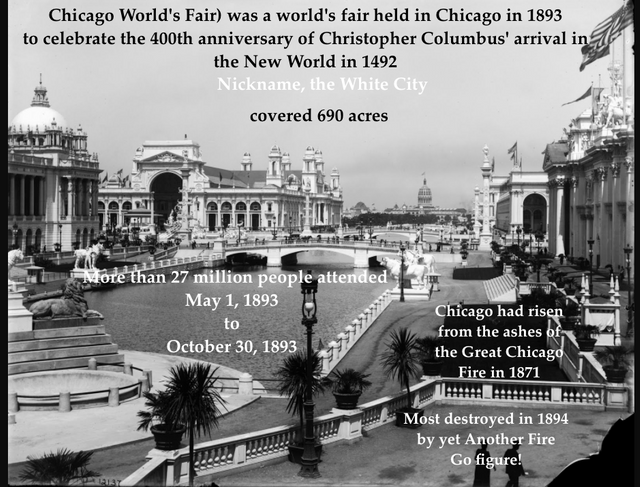
Thank you for this following link Great Patriot/Warrior Michael Steele
Howdie Mickoski Talks called
Chicago Columbia Exposition 1893- Was it built, or was it an ancient city repaired?
They built it all from 1891 to 1893
This took me on a deep dive where I looked into many characters involved with Burnham. Their history is Very Interesting.
The Chicago Exposition was a 690 acre site.
Supposedly built from scratch in 2 years.
That included all the
Planning
Construction of the buildings
Landscaping
All the Canals dug
The Roads and Sidewalks put up
The midway rides up and all of it running
What kind of planning does that require to be producing buildings like this?
Everything was supposedly built over top of a swamp.
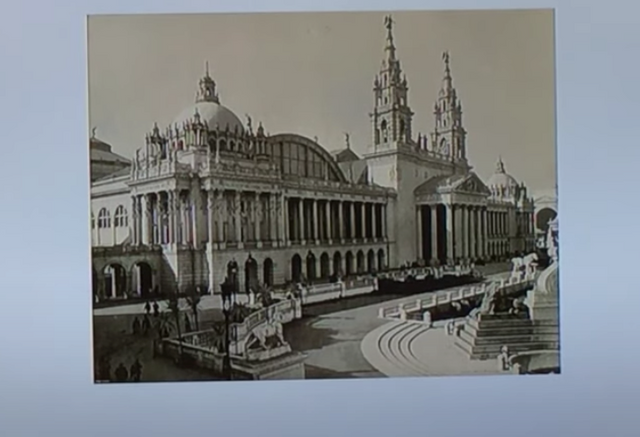
Even if you had 100,000 workers to do the job. ..Chicago claimed they had 40,000. . .who was feeding them every day? Where did the materials come from how did they get to the site.
Does something not add up?
How were they feeding all of those people daily and how did they get all of those elaborate building done in just two years time?
Where did all of the bathrooms go for that work force? Where did the materials go?
All done without any modern machines, trucks or supposedly without any electrical power.
Here is one of 14 Giant Buildings along with several other buildings on the site only built in 2 years time? What's going on?
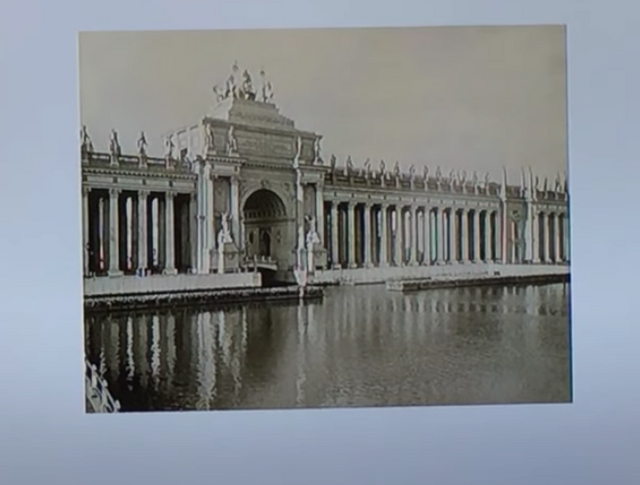
Then it was all destroyed.
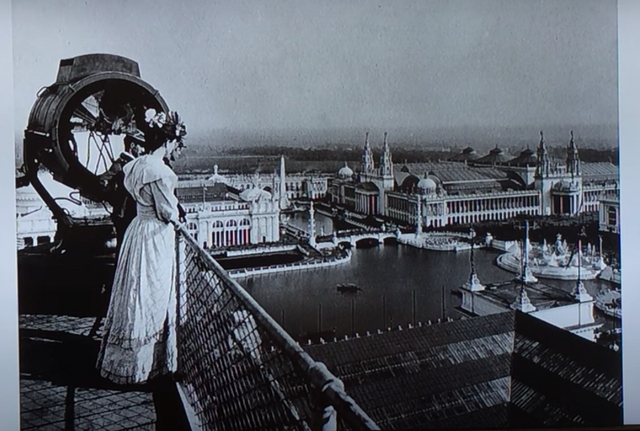
A Building Contractor said it would take 2 years just have the architectural plans drawn up.
With a Complex building project like this it takes excellent planning to pull it off.
Lakes were made and dug up so that they wouldn't flood. All would take 10-15 years with modern machines, a large work and unlimited budget.
A Building Contractor said it was Not possible this could be built in 2 years in the 1890's.
This was the exposition
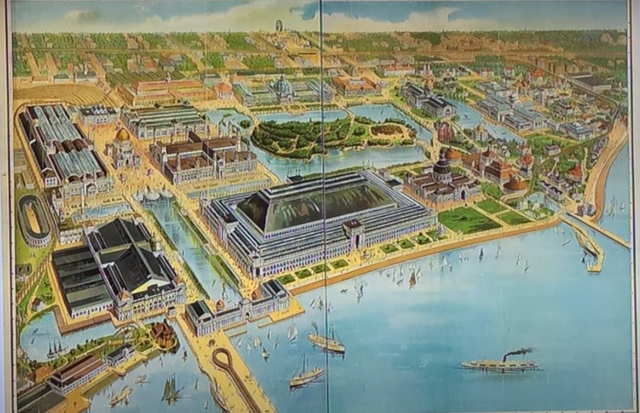
Manufacturer's building was the largest building on earth at the time and could house 300,000 people.
The whole layout provided each state had it's own building.
Countries with buildings
Then the Midway in the back with it's giant ferris wheel
The University of Chicago across from the Midway was also being built at the same time.
It was claimed by Historians that because the buildings were made of Temporary Material invented in Paris a few years earlier which allowed these massive buildings to be built quickly and cheaply.
Would you want to put together such fine ornaments if it's a temporary structure and it's not solid and complete?
A ticket to this World's Fair
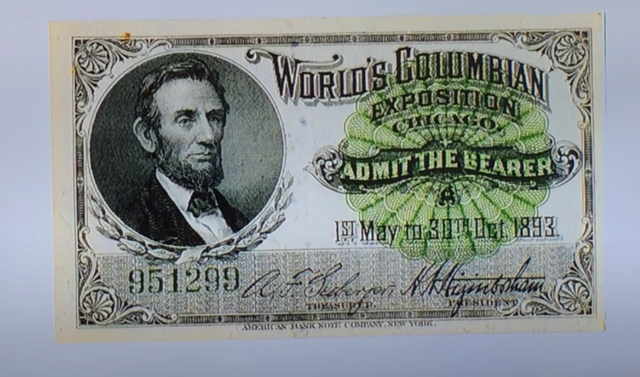
Note it says "Admit the Bearer"
The two architects from the exposition from a photo in 1890
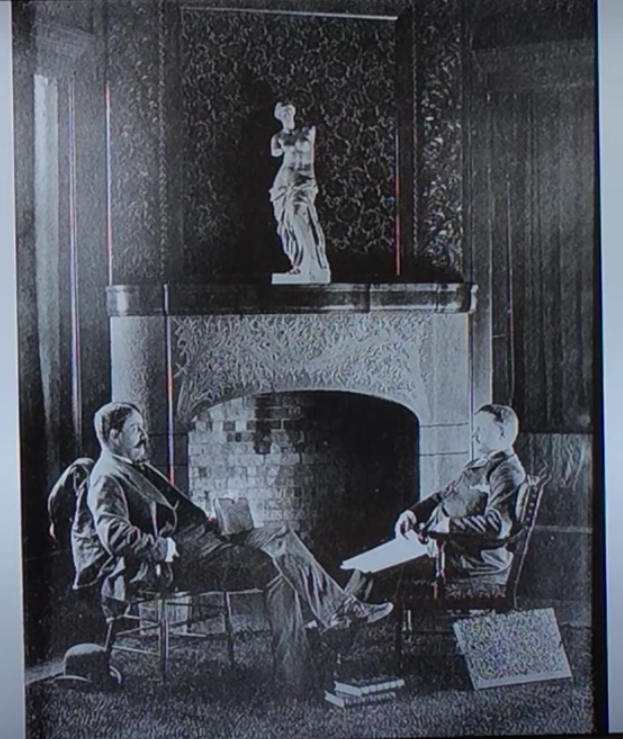
John Root and Daniel Burnham
During their eighteen years of partnership, Burnham and Root designed and built residential and commercial buildings. Their success was crowned with the coordination of the World's Columbian Exposition (World's Fair) in 1893. The two men met when they worked as apprentice draftsmen in the offices of Drake, Carter, and Wight in 1872. A year later they established their own architecture office and began work by building private residences for the wealthy elite of Chicago's meat industry. Both of them married into wealthy families which allowed them to establish a basis for their business. "Daniel Hudson Burnham was one of the handsomest men I ever saw," said Paul Starrett who joined Burnham and Root in 1888 (later he designed the Empire State Building). "It was easy to see how he got commissions. His very bearing and looks were half the battle". While Burnham was the pragmatic designer and impressive salesperson, Root became the creative genius of the company. When Burnham and Root were together, one woman said "I used always to think of some big strong tree with lightning playing around it". Louis Sullivan, the famous architect, called Burnham "a colossal merchandiser" obsessed with building the biggest and costliest structures of the city.
The most significant buildings designed by Burnham and Root were built in the late 1880s and early 1890s. That is when Root's designs actually paved the way for modern day skyscrapers. Until then, buildings relied on exterior masonry for support, limiting their height to 12 stories. The invention of steel support beams gave him the possibility to build higher and to add more windows.
Root died in 1891, leaving his greatest project incomplete. Daniel Burnham, despite only having practical experience and no formal training in the field of architecture, was then given the responsibility to finish coordinating the fair.
Why within one year after getting the contract did Root die? Coincidence?
One of the main Garden Architects also died before the fair opened.
The projects begun by Root were completed, including the Masonic Temple in 1892, which was for a short period the tallest building in the world at 22 stories.
Just look at those Numbers! 11 two times and we all Know the cabal Loves 11 for signaling destruction so they can destroy, then come in as the saviors to rebuild their New dream.
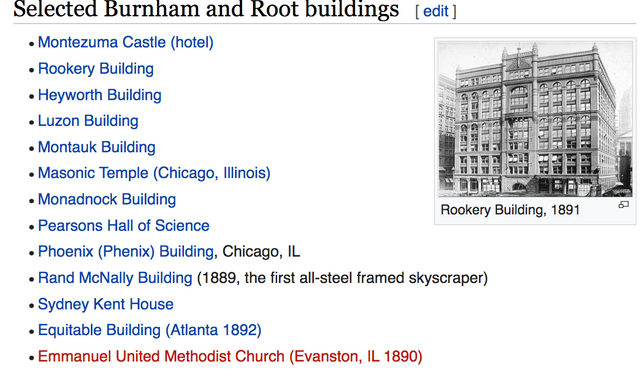
Daniel Burhnam
Burnham was from the Church of New Swedenurg.
He tried to get into Yale and Harvard, but was denied so started learning drafting.
Director of Works for the 1892–93 World's Columbian Exposition, colloquially referred to as "The White City".
John Root
His unexpected passing sent shock waves through the city and the architectural community. Not only had Root just turned 41 years old five days earlier, but he and partner Daniel H. Burnham were in the early stages of planning the World’s Columbian Exposition – by far the largest and most important project their firm had ever undertaken.
The tragic story of Root’s death has oft been retold. As recounted in the death notice published in the Chicago Tribune on Friday January 16th:
In the prime of his life, his vigor, and his usefulness; in the midst of his invaluable services to the World’s Columbian Exposition, he seemed to be the man of all others who would be sure to continue for many a day one of its most esteemed and beloved citizens. In the flower of his days pneumonia has suddenly ended his life, as it has during late years ended the lives of so many men young and strong like him. Less than a week ago he was in the best of health. Saturday he took a Turkish bath and later at his own house thoughtlessly stepped into the street to hand a friend to her carriage, becoming slightly chilled in so doing. During Sunday he received at his hospitable home a visit from the Eastern architects visiting the scene of the World’s Fair, and that night he was seized with a severe chill, which proved the beginning of a fatal illness. Even as late as noon of that day of his death he seemed in a fair way of recovery, but death came suddenly last evening.”
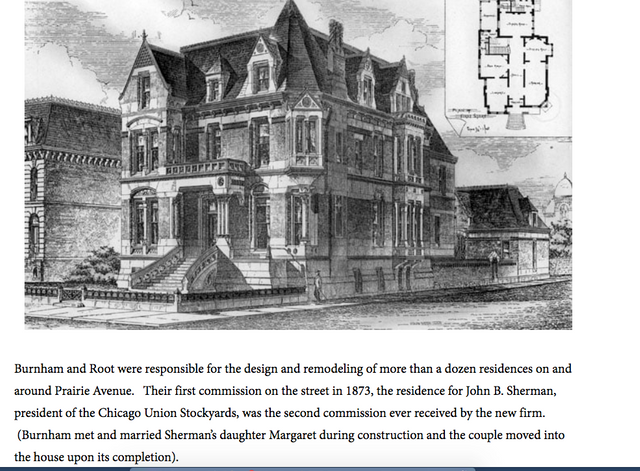
In 1880, Root married Mary Louise Walker, a daughter of James M. Walker of 1720 S. Prairie Avenue. The newly married couple took up residence with the Walkers, but Mary Root died a month later at the age of 21.
The Glessners were long-time friends of Daniel Burnham and would have known Root through that friendship. Frances Glessner and Root’s wife were both members of The Fortnightly. She sent flowers and a note of condolence to Root’s widow, which were acknowledged with the following note on March 18th:
“Dear Mrs. Glessner
I thank you from my heart for the beautiful roses, and above all for the sweet sympathy which I know accompanied them. I shall never forget that you thought of me when I most needed help.
Always faithfully yours,
Dora Louise Root”
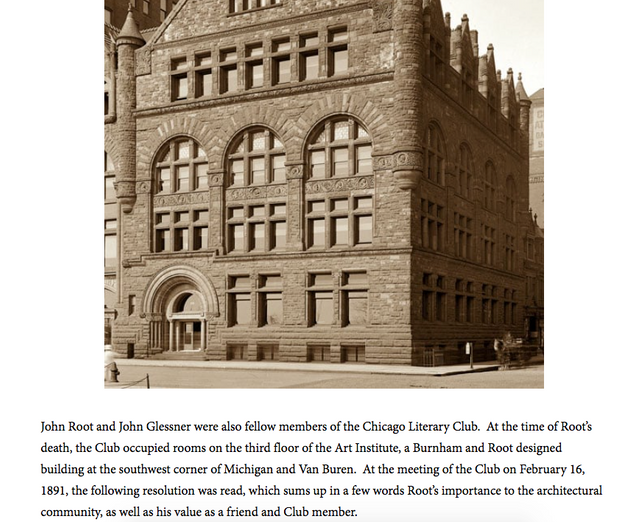
Only a few knew him as a musician, and yet he had rare musical gifts. Many surpassed him in mere brilliance of execution, but he had few equals in interpreting the spirit of the great composers. To hear him play from memory Mendelssohn’s “Songs Without Words” was a revelation. It stirred the deepest emotions.
“He died at the age of 41, young even for his years, doing the best work of his life,
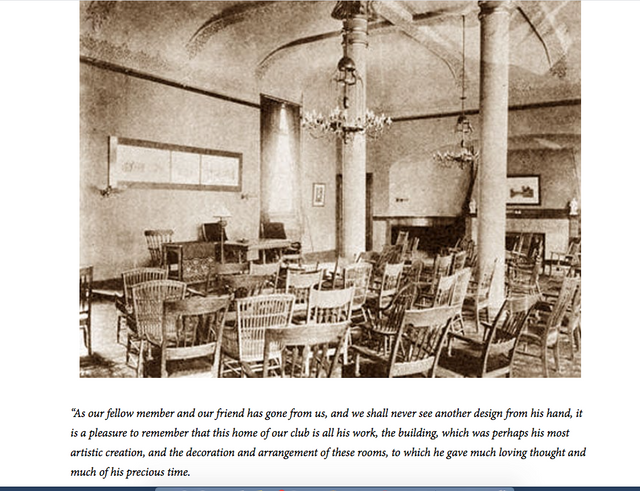
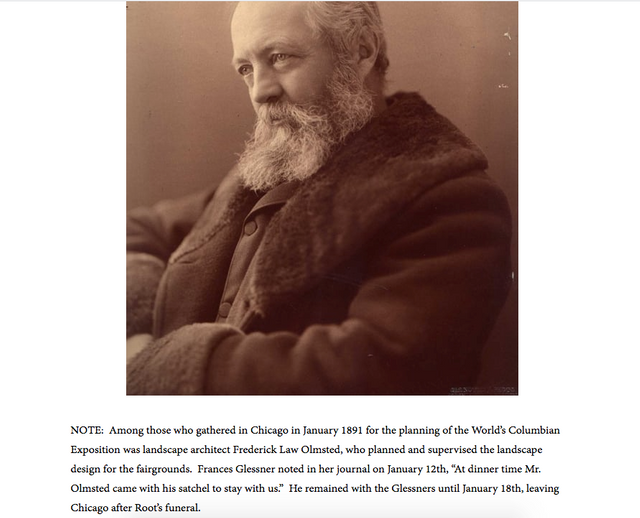
Burnham actually came out of nowhere and was not known until he married Sherman's daughter. He got his first job on Sherman's mansion. Prior had only drafted.
It was through Sherman that Burnham began to get contracts.
All of a sudden Burnham became known for famous works amounting to 14.7 Million Square feet of building from all over the United States and even in Manila in the Philippines.
All over New York, Chicago, Washington, San Francisco, Detroit.
How did he even have Time for all of that? How does One man do all of that as he was only early 40's when he died?
He was also the famous architect of the Montauk and the Masonic Temple buildings in Chicago.
This is starting to sound like all of the reach that Herbert Hoover had when he got to mine all over the world and help teams of designers in California.
What reach he had as he was on the Board of the Stanford Research Trust then became president so as to connect both the West coast with the East coast. Lots of influence and power.
See more here as he had a Lot of control being the head of Mining firms that reached into Australia, China and other places.
https://www.minds.com/blog/view/1200510509534715904
The Montauk building was interesting considering,
Inside the real-life lab and ‘secret experiments’ that inspired ‘Stranger Things’
https://nypost.com/article/camp-hero-montauk-project-conspiracy/
If you haven't watched the series Stranger Things it has many tells inside on how things Actually do operate and especially how the Controllers Keep control over what can be spoken about!
According to Britannica,
Burnham was the sixth of seven children and the youngest son. His parents were members of the Church of the New Jerusalem (now New Church), or Swedenborgians, a maverick Christian religious sect named for Emanuel Swedenborg, a Swedish scientist and mystic who disagreed with church hierarchy and stressed being of service to others.
Burnham and his family moved to Chicago in January 1855. There he attended Snow’s Swedenborgian Academy and later Central High School, where he was remembered for his leadership and artistic ability. In 1863, after he had graduated, his parents sent him to the newly incorporated New-Church Theological School in Waltham, Massachusetts, for further study. He prepared for college with a Swedenborgian tutor, the Reverend Tilly Brown Hayward.
Through Hayward, Burnham met the architect and writer W.P.P. Longfellow, who encouraged Burnham’s interest in architecture. When it came time to take his college entrance exams at Harvard and Yale, he failed both because he was “not able to write a word,” as he later recalled. Years later both universities would award him honorary degrees.
So another example that it doesn't Really Matter about Academia as the arrogant Claim, but rather Who you Know and whether or not You can further the Elite Globalist's agenda!
Here was Another IN for Burnham,
Returning to Chicago, Burnham became a draftsman for the famed civil engineer and architect William Le Baron Jenney. He wrote to his mother in 1868 that he would become “the greatest architect in the city and country.” Nevertheless, ambitious, young, and restless, he quit his job with Jenney in order to seek his fortune in Nevada, where he tried mining and also ran for the state senate. Unsuccessful in both attempts, he returned to Chicago in 1870 ready to begin an architectural career in earnest.
Talk about laying the "groundwork and labyrinth" as Hoover did in his mining "missions" and reach!
Does ANYONE see anything at all interesting about this considering Snow was the President in the Hunger Games series?
I know, the others would say, "just a coincidence!" But the Awake group knows Better!
Burnham attended
Snow’s Swedenborgian Academy
He also joined the Burnham joined the Swedenborgian Church
The US church was organized in 1817 with the founding of the General Convention of the New Church (sometimes shortened to the Convention), now also known as the Swedenborgian Church of North America.
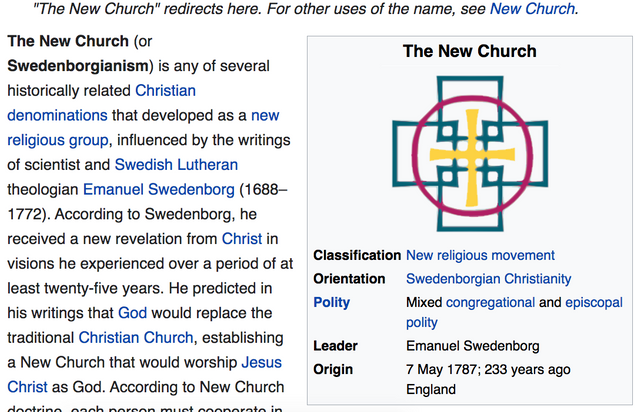
Swedenborg had a prolific career as an inventor and scientist. In 1741, at 53, he entered into a spiritual phase in which he began to experience dreams and visions, notably on Easter Weekend, on 6 April.
Another connection to mining
Swedenborg's father, Jesper Swedberg (1653–1735), descended from a wealthy mining family, the first known paternal ancestor being Otte Persson from Sundborn parish, mentioned 1571.
Another example that All of these people in High Places Already had wealth, influence or access to those who were wealthy and connected!
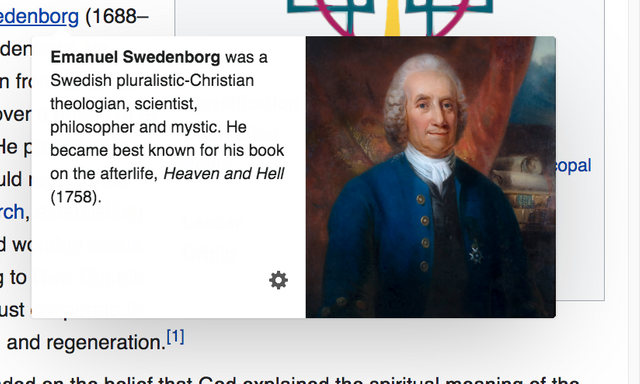
He (Swedenborg's father) travelled abroad and studied theology, and on returning home, he was eloquent enough to impress the Swedish king, Charles XI, with his sermons in Stockholm. Through the king's influence, he would later become professor of theology at Uppsala University and Bishop of Skara.
Jesper Swedberg (Swedenborg's father) took an interest in the beliefs of the dissenting Lutheran Pietist movement, which emphasised the virtues of communion with God rather than relying on sheer faith (sola fide). Sola fide is a tenet of the Lutheran Church, and Jesper was charged with being a pietist heretic. While controversial, the beliefs were to have a major impact on his son Emanuel's spirituality.
In 1715 Swedenborg returned to Sweden, where he devoted himself to natural science and engineering projects for the next two decades. A first step was his meeting with King Charles XII of Sweden in the city of Lund, in 1716. The Swedish inventor Christopher Polhem, who became a close friend of Swedenborg, was also present. Swedenborg's purpose was to persuade the king to fund an observatory in northern Sweden. However, the warlike king did not consider this project important enough, but did appoint Swedenborg to be assessor-extraordinary on the Swedish Board of Mines (Bergskollegium) in Stockholm.
From 1716 to 1718, Swedenborg published a scientific periodical entitled Daedalus Hyperboreus ("The Northern Daedalus"), a record of mechanical and mathematical inventions and discoveries. One notable description was that of a flying machine, the same he had been sketching a few years earlier.
Tried to track down a clip, but surprise, surprise they don't Want you to see it!

Tracked this archive here,

https://archive.org/details/swedenborgs1714a0000sode
In 1718, Swedenborg published an article that attempted to explain spiritual and mental events in terms of minute vibrations, or "tremulations".
Upon the death of Charles XII, Queen Ulrika Eleonora ennobled Swedenborg and his siblings. It was common in Sweden during the 17th and 18th centuries for the children of bishops to receive that honor, as a recognition of the services of their father. The family name was changed from Swedberg to Swedenborg.
This and the flying machine are Interesting considering. . .
What Keely did and Andrews
Upon the death of Charles XII, Queen Ulrika Eleonora ennobled Swedenborg and his siblings. It was common in Sweden during the 17th and 18th centuries for the children of bishops to receive that honor, as a recognition of the services of their father. The family name was changed from Swedberg to Swedenborg.
In 1724, he was offered the chair of mathematics at Uppsala University, but he declined and said that he had dealt mainly with geometry, chemistry and metallurgy during his career. He also said that he did not have the gift of eloquent speech because of a stutter, as recognized by many of his acquaintances; it forced him to speak slowly and carefully, and there are no known occurrences of his speaking in public.
During the 1730s, Swedenborg undertook many studies of anatomy and physiology. He had the first known anticipation of the neuron concept. It was not until a century later that science recognized the full significance of the nerve cell. He also had prescient ideas about the cerebral cortex, the hierarchical organization of the nervous system, the localization of the cerebrospinal fluid, the functions of the pituitary gland, the perivascular spaces, the foramen of Magendie, the idea of somatotopic organization, and the association of frontal brain regions with the intellect. In some cases, his conclusions have been experimentally verified in modern times.
In the 1730s, Swedenborg became increasingly interested in spiritual matters and was determined to find a theory to explain how matter relates to spirit. Swedenborg's desire to understand the order and the purpose of creation first led him to investigate the structure of matter and the process of creation itself. In the Principia, he outlined his philosophical method, which incorporated experience, geometry (the means by which the inner order of the world can be known) and the power of reason. He also outlined his cosmology, which included the first presentation of his nebular hypothesis. (There is evidence that Swedenborg may have preceded Kant by as much as 20 years in the development of that hypothesis.
In 1735, in Leipzig, he published a three-volume work, Opera philosophica et mineralis in which he tried to conjoin philosophy and metallurgy. The work was mainly appreciated for its chapters on the analysis of the smelting of iron and copper, and it was the work that gave Swedenborg his international reputation. The same year, he also published the small manuscript de Infinito ("On the Infinite") in which he attempted to explain how the finite is related to the infinite and how the soul is connected to the body.
He also conducted dedicated studies of the fashionable philosophers of the time such as John Locke (also a character in Lost) and others.
In 1743, at the age of 55, Swedenborg requested a leave of absence to go abroad. His purpose was to gather source material for Regnum animale (The Animal Kingdom, or Kingdom of Life), a subject on which books were not readily available in Sweden. The aim of the book was to explain the soul from an anatomical point of view. He had planned to produce a total of 17 volumes.
In June 1747, Swedenborg resigned his post as assessor of the board of mines. He explained that he was obliged to complete a work that he had begun and requested to receive half his salary as a pension. He took up afresh his study of Hebrew and began to work on the spiritual interpretation of the Bible with the goal of interpreting the spiritual meaning of every verse.
Swedenborg believed that higher knowledge is not something that can be acquired, but that it is based on intuition.
Here is one of his theories
The basis of the correspondence theory is that there is a relationship among the natural ("physical"), the spiritual, and the divine worlds. The foundations of this theory can be traced to Neoplatonism and the philosopher Plotinus in particular. With the aid of this scenario, Swedenborg now interpreted the Bible in a different light, claiming that even the most apparently trivial sentences could hold a profound spiritual meaning. Swedenborg argued that it is the presence of that spiritual sense which makes the Word divine.
Now this Does coincide with. . .
2 Timothy 3:16
All scripture is given by inspiration of God, and is profitable for doctrine, for reproof, for correction, for instruction in righteousness:
So back to Snow’s Swedenborgian Academy
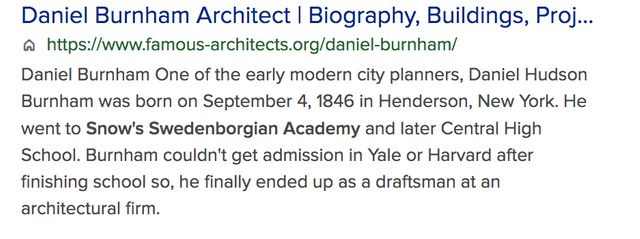
In 1863, after he had graduated, his parents sent him to the newly incorporated New-Church Theological School in Waltham, Massachusetts, for further study
a seminary specializing in New Church theology and located in Bryn Athyn, Pennsylvania.
The primary focus of this school is on training men to serve as pastors in the General Church of the New Jerusalem.
The Theological School has been accredited by the Middle States Association since 1952. This accreditation was reaffirmed most recently in 2003.
Burhanm'a Swedenborgian tutor, the Reverend Tilly Brown Hayward.
See his works here,
https://onlinebooks.library.upenn.edu/webbin/book/lookupname?key=Hayward%2C%20Tilly%20Brown%2C%201797-1878
More on Burnham,
In 1872 Burnham joined the office of Carter, Drake & Wight, where he met John Wellborn Root, a talented architect and the office foreman. Burnham, eager to start his own firm, persuaded Root to become his partner a year later. Root was primarily responsible for design while Burnham planned the layout of their building interiors and organized the business. As best friends and professional colleagues, they worked closely together. Of their business relationship, their one-time boss Peter Wight recalled in a 1912 address before the Illinois chapter of the American Institute of Architects:
The two architects who formerly only had drafting experience prior to the Sherman mansion were expanded when destruction hit.
Two events triggered a period of extraordinary growth in Chicago: the end of the Civil War and the Chicago fire of 1871.
Burnham, always thinking big, was quick to recognize the needs of commercial clients. A series of bold solutions to some of the challenges of building higher structures provided examples for others to follow and led Burnham & Root to the forefront of their profession. As an example, for the 10-story Montauk Block (1882–83)—perhaps the first building to be labeled a “skyscraper”—Burnham & Root devised a new kind of foundation footing. This footing, consisting of a broad slab of concrete reinforced with iron rails, allowed the Montauk, and future taller, heavier buildings, to be built in Chicago’s unstable soil.
Burnham & Root also extended the typical Chicago construction time frame by continuing to build throughout the winter months. They used a tentlike structure over the site and placed heaters inside. Additionally, the Montauk was noteworthy for its fireproofing system, which employed a hollow tile subfloor and tiles to encase both beams and columns, and was hailed as one of the first truly fireproof buildings. The Montauk Block created a new urban scale for commercial structures, while its form and plain surfaces reflected an aesthetic based on functionality, a hallmark of the new commercial architecture.
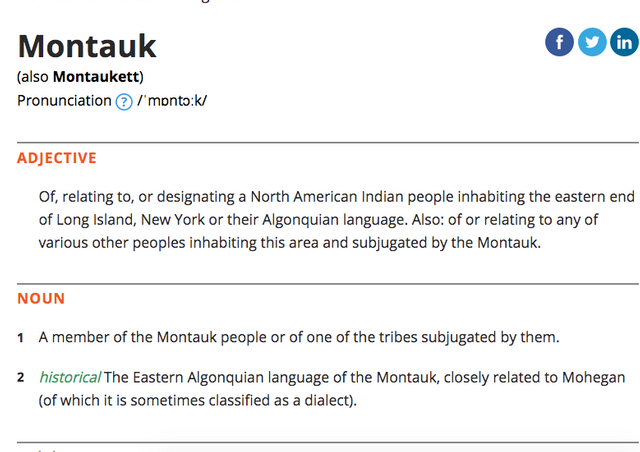
Among their other notable early works are the Rookery (completed 1886), the second Rand McNally Building (completed 1890, demolished 1911...There's That date.
Quite the list of buildings and influence. Quite the feat for someone who studied under those who had mining experience.
Among their other notable early works are the Rookery (completed 1886), the second Rand McNally Building (completed 1890, demolished 1911), the Monadnock Building (completed 1891), and the Masonic Temple (completed 1892). Finished a year after William Le Baron Jenney’s Home Insurance Building (completed 1885), which was the first building to use structural steel members for partial support, the Rookery used both a masonry load-bearing wall and a skeleton frame (a grid of vertical steel columns and horizontal steel beams) in its construction. But it is the smaller Rand McNally Building that is credited as the first steel-frame building. Burnham & Root’s 16-story Monadnock Building reached the tallest practical height using traditional construction techniques. At 21 stories high, Burnham & Root’s Masonic Temple with its great atrium would be a wonder: the tallest office building in the world in terms of occupied floors. In their 18-year partnership, Burnham and Root built nearly 300 structures—among them railroad stations, warehouses, office buildings, residences, armories, schools, clubs, and churches.
Burnham’s extraordinary leadership skills were made manifest when he became the director of works at the World’s Columbian Exposition of 1893. Burnham & Root were first named consulting architects, but Burnham resigned that position to become head of construction. When Root died suddenly in January 1891, Burnham assumed responsibility for overseeing and completing construction for some 150 buildings on more than 600 acres (240 hectares) of land.
In little more than two years, working with America’s most noted architects and designers, Burnham developed America’s most spectacular world’s fair of the 19th century. He led a workforce that reached 10,000 men, reviewed guidelines for the many state buildings, and oversaw the fair’s infrastructure, including transportation, sewage, and clean water delivery systems. Nicknamed the “White City,” the fair’s grand Neoclassical buildings were planned as a cohesive whole in a landscaped setting; they made a lasting impression on millions of visitors. Often noted as the inspiration for the City Beautiful movement, the fair proved to be a turning point both for Burnham and for the development of the modern American city.
My question is Who do they always Choose to further their agenda?
This is who Burnham embraced. ..
friend the architect Charles F. McKim of McKim, Mead & White. Burnham’s firm completed designs for more than 200 buildings in the next 20 years, including many that are significant in American architectural history.
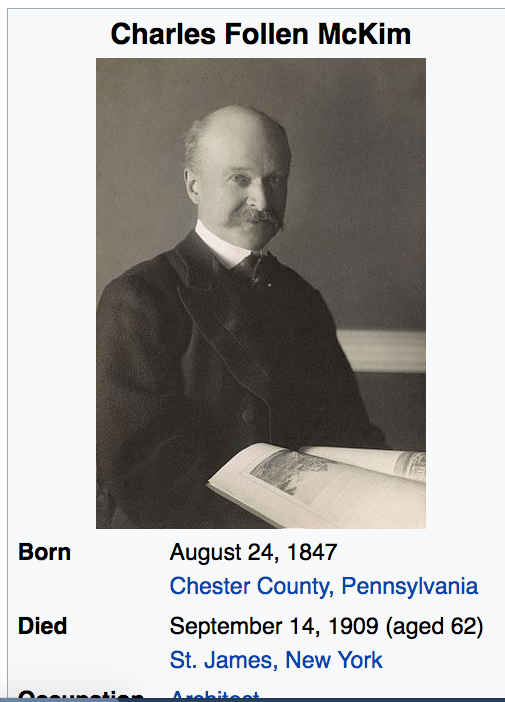
After attending Harvard University, he studied architecture at the École des Beaux-Arts in Paris before joining the office of Henry Hobson Richardson in 1870. McKim formed his own firm in partnership with William Rutherford Mead, joined in 1877 by fellow Richardson protégé Stanford White.
McKim became best known as an exponent of Beaux-Arts architecture in styles of the American Renaissance, exemplified by the Boston Public Library (1888–95), and several works in New York City, including the Morningside Heights campus of Columbia University (1893), the University Club of New York (1899), the Pierpont Morgan Library (1903), New York Penn Station (1904–10), and The Butler Institute of American Art in Youngstown, Ohio (1919). He designed the Howard Mansion (1896) at Hyde Park, New York.
Just interesting is all



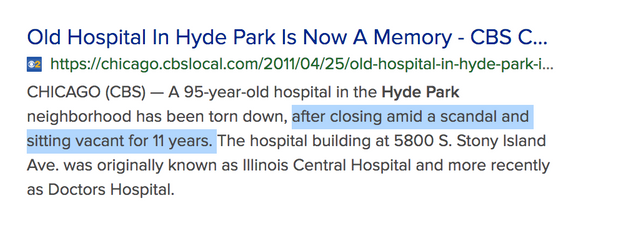
Interesting. ..lots of 11's and this done in 2011
https://chicago.cbslocal.com/2011/04/25/old-hospital-in-hyde-park-is-now-a-memory/
Elitists with All the reach so More Super Connection for Burnham (even though the controllers and media feign it was all grassroots. . .Never is
McKim was a member of the Congressional commission for the improvement of the Washington park system, the New York Art Commission, the Accademia di San Luca (Rome, 1899), the American Academy in Rome and the Architectural League. He was an honorary member and former president of the American Institute of Architects, and honorary member of the Society of Mural Painters. He became a National Academician in 1907. He belonged to the University, Lambs, Racquet and Tennis Clubs of New York, and to the St. Botolph and Somerset Clubs of Boston.
More reach and a serious labyrinth of What Lies Beneath when one thinks about it.
Other notable Burnham structures are the famous Flatiron Building (completed 1902) in New York City; the Field Museum (completed 1920) in Chicago; the Frick and Oliver buildings (completed 1902 and 1910, respectively) in Pittsburgh; a series of department stores such as Wanamaker’s (1909) in Philadelphia, Selfridges (completed 1909) in London, Marshall Field & Company (completed 1907) in Chicago, and Gimbels (completed 1912) in Manhattan; and Union Station (completed 1907) in Washington, D.C.
The vast web is Wide
https://steemit.com/qanon/@artistiquejewels/obama-a-publishing-company-and-jimmy-fallon-what-are-all-the-connections-follow-the-money-why-are-the-elitists-so-attracted-to
In 1901, Burnham became the de facto chairman of the Senate Park Commission, also called the McMillan Commission (for Michigan’s U.S. Sen. James McMillan, who was chairman of the Senate Committee on the District of Columbia). Burnham invited his friend McKim and Frederick Law Olmsted, Jr. (son of the famous landscape architect with whom Burnham had worked on the fair), to join him in re-envisioning and enlarging Pierre-Charles L’Enfant’s original 1791 plan: they undertook much of the actual work. Under Burnham’s leadership and based on precedents in Paris and especially Rome, the team envisioned a grand, ordered national capital to reflect America’s status as an emerging world power. Their plan for the capital city included a comprehensive park system and redefined the National Mall and surrounding area. Burnham further conceived of Union Station, the railway station, as a formal public gateway to the city’s monumental core and as a feature integral to the city plan. Upon publication the McMillan Plan received widespread attention and approval.
Now everyone by this time is Well aware of what resides underneath D.C. and is verified.
https://www.bloomberg.com/news/articles/2018-10-30/mapping-all-the-tunnels-under-washington-d-c
Ancient tunnels under D.C. and London verified in here with photographs and verified source links.
FEMA tunnel network and more info found in here,
What is Giant Voice. Tweeted prior to PreZ Trump's Suspension. Military Mass Comm System? Here is the evidence. History, Power and Reach of FEMA.
https://www.minds.com/blog/view/1199417708385587200
Fueled by the Progressive era’s interest in municipal improvement, other cities requested Burnham’s planning services. In 1902–03 Burnham, with architects Arnold W. Brunner and John M. Carrère, prepared for the city of Cleveland a “Group Plan” for a new downtown civic centre of Beaux Arts buildings formally arranged around a rectangular park. In 1905, under the auspices of leading private citizens organized as the Association for the Improvement and Adornment of San Francisco, Burnham devised for San Francisco a far more comprehensive plan. However, in the aftermath of the 1906 earthquake, this plan was not implemented. In the meantime, Burnham’s architectural practice continued to flourish. So famous had he become as a city planner that, when the Philippines were ceded to the United States after the Spanish American War, Burnham was asked by the federal government to create a “Beautification Plan” for Manila and to design an entirely new summer capital, Baguio, in the Luzon highlands.
All interesting considering. ..
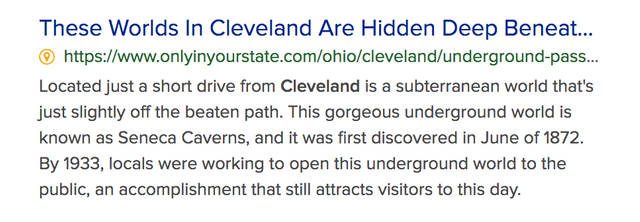
https://www.onlyinyourstate.com/ohio/cleveland/underground-passaeways-cle/


https://clevelandhistorical.org/items/show/736
Interesting considering there is a tie in to Robert and Ghislaine Maxwell concerning the subterranean.
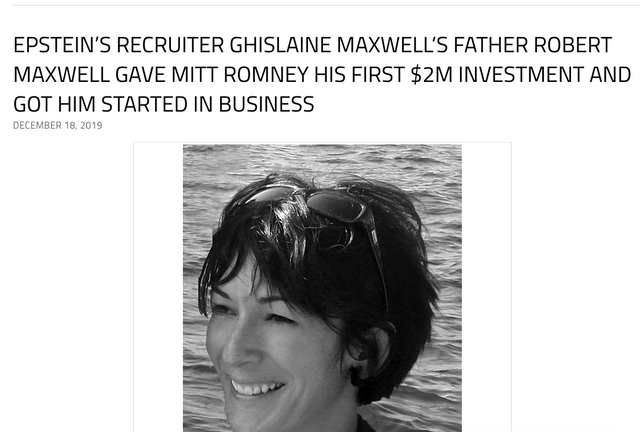
SUPERYACHTS ,SUBMARINES, GHISLAINE MAXWELL COULD PROCURE DUAL CITIZEN OCEAN PASSPORTS TERRA MAR
https://www.bitchute.com/video/0XV4HTQ-zTI/
EPSTEIN'S GIRLFRIEND GHISLAINE MAXWELL HER ORG TERRA MAR AND ASSOCIATION WITH MILK STUDIOS
https://www.bitchute.com/video/4PKEMu0MFifK/
Connect to Burnham's connections with Rome, his mining connects and what is Under the Vatican. . .
CONNECTIONS OF EPSTEIN, A MODEL/ ENTREPRENEUR THAT LEADS TO TIES WITH THE VATICAN
https://www.bitchute.com/video/jvJyPSZIPSzu/
ROBERT MAXWELL HIS REAL NAME, HIS POSITION IN ARMY, UKRAINE BIRTH, TRIPS 1950'S YT WOULDN'T LET THRU
https://www.bitchute.com/video/W60trck60wOS/
ROBERT MAXWELL CONNECTIONS TO INDUSTRY SIMILAR TO EPSTEIN. WAS GHISLAINE MAXWELL LIKE HER FATHER?
https://www.bitchute.com/video/4aG30s8J2oP8/
See the glut, greed and issues with San Francisco from the early days of these Career Politicians Still there!
https://www.ucanews.com/news/shining-a-light-on-pedophilia-in-the-philippines/71561
The Las Vegas shooter and brother also connected to the Philippines and a certain camp there.
https://steemit.com/borderlinegrillshooting/@artistiquejewels/information-on-the-shooter-at-borderline-grill-in-thousand-oaks-some-of-victims-present-at-las-vegas-concert-shooting
Looks like a lot of Great Excuses for access if needed.
Burnham thus brought a lifetime of experience to his masterwork, the 1909 Plan of Chicago, written with his young associate, Edward Bennett. Published by and written for the Commercial Club of Chicago, a private group of civic-minded business leaders who worked closely with Burnham on the report, the book is considered a landmark in urban planning history. It recognized the city in its context, not as an isolated collection of buildings but as an organic whole interconnected with and interrelated to its region. It encompassed a 60-mile radius that included three states and Lake Michigan. Visionary yet detailed.
Interesting. . .Sounds just like the Elitists Now and Then!
Some critics noted even at the time that it ignored housing and other pressing urban social issues.
More from Britannica
Burnham’s unpublished draft of the Plan, however, does include a remarkable social agenda. Others since have argued that Burnham’s plan represents an elitist viewpoint with an emphasis on social control and order; (you don't say?) it is, these critics argue, too comprehensive to be fully realized and too monumental to be humane. Nonetheless, the Plan of Chicago has inspired generations of Chicagoans and others to work toward the ideal of a beautiful, efficient city.
Really? Because. . .
We all see this,


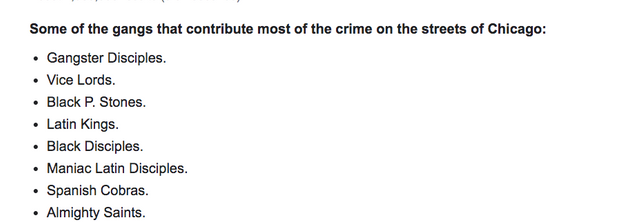
But hey, isn't it great the "architects and elitist private clubs" built them a labyrinth with their masonry skills!
Hmmm. ..interesting.
Britannica spent all of that time singing his praises and talking about all of his contributions to Chicago then. . .
Burnham did not see any aspect of his Chicago plan realized. Already diagnosed with diabetes, he died on June 1, 1912, of food poisoning while on a trip abroad and is buried in Graceland Cemetery in Chicago.
Why did the same thing happen to San Francisco?
Interesting that when Burnham died. ..so did this friend of his who also decorated at the World's Fair in Chicago, who ended up on the Titanic.

At age fifteen, Millet entered the Massachusetts regiment, first as a drummer boy and then a surgical assistant (helping his father, a surgeon) in the American Civil War.
He repeatedly pointed to his experience working for his father as giving him an appreciation for the vivid blood red that he frequently used in his early paintings. He graduated from Harvard with a Master of Arts degree. He worked as a reporter and editor for the Boston Courier and then as a correspondent for the Advertiser at the Philadelphia Centennial Exposition.
He was made a trustee of the Metropolitan Museum of Art, and sat on the advisory committee of the National Gallery of Art. He was decorations director for the World's Columbian Exposition in Chicago in 1893, with claims he invented the first form of compressed air spraypainting to apply whitewash to the buildings, but the story may be apocryphal as contemporary journals note spraypainting had already been in use since the early 1880s.[5] His career included work on a number of worlds' fairs, including Vienna, Chicago, Paris, and Tokyo, where he made contributions as a juror, administrator, mural painter/decorator, and adviser.
Millet was involved with the American Academy in Rome from its inception and served as secretary from 1904 to 1911. He was a founding member and vice chairman of the U.S. Commission of Fine Arts, serving from 1910 until his death in 1912. He died aboard the Titanic while traveling to New York City on Academy business.
Millet was close friends with Augustus Saint-Gaudens and Mark Twain, both of whom attended his 1879 wedding to Elizabeth ("Lily") Greely Merrill in Paris, France; Twain was Millet's best man.
Millet was acquainted with the famed American portraitist John Singer Sargent, who often used Millet's daughter Kate as a model. He was also close to the esteemed Huxley family.
The patriarch of the family was the zoologist and comparative anatomist Thomas Henry Huxley (1825–1895). His grandsons include Aldous Huxley (author of Brave New World and The Doors of Perception) and his brother Julian Huxley (an evolutionary biologist and the first director of UNESCO) and the Nobel laureate physiologist Andrew Huxley.
Thomas Henry Huxley (1825–1895) was an English biologist. Known as "Darwin's Bulldog" for his defence of Charles Darwin's theory of evolution. Mostly a self-educated man, he had an extraordinary influence on the British educated public. He was instrumental in developing scientific education in Britain, and opposed those Christian leaders who tried to stifle scientific debate. He was a member of eight Royal Commissions and two other commissions. A noted unbeliever, he used the term "agnostic" to describe his attitude to theism.
Though Huxley was a great comparative anatomist and invertebrate zoologist, perhaps his most notable scientific achievement was his work on human evolution.
The read of the Huxley family history is filled with mental instability and oddities.
Millet lived with Archibald Butt, who called him "my artist friend who lives with me", in a large mansion at 2000 G Street NW. They were known for throwing spartan but large parties that were attended by members of Congress, justices of the Supreme Court, and President Taft himself. There is some speculation that Butt and Millet were gay lovers. Historian Richard Davenport-Hines wrote in 2012:
In 1913, the Butt-Millet Memorial Fountain was erected in Washington, D.C., in memory of Millet and his long-time friend Archibald W. Butt, with whom he shared a home.
This taken from here,
https://www.bookscool.com/en/The-Devil-in-the-White-City-Murder-Magic-and-Madness-at-the-Fair-That-Changed-America-431135/39
The Devil in the White City: Murder, Magic and Madness at the Fair That Changed America
Aboard the Olympic
ABOARD THE OLYMPIC BURNHAM waited for more news of Frank Millet and his ship. Just before sailing he had written, in longhand, a nineteen-page letter to Millet urging him to attend the next meeting of the Lincoln Commission, which was then on the verge of picking a designer for the Lincoln Memorial. Burnham and Millet had lobbied strongly for Henry Bacon of New York, and Burnham believed that his earlier talk to the Lincoln Commission had been persuasive. “But—I know and you know, dear Frank, that … the rats swarm back and begin to gnaw at the same old spot, the moment the dog’s back is turned.” He stressed how important it was for Millet to attend. “Be there and reiterate the real argument, which is that they should select a man in whom we have confidence. I leave this thing confidently in your hands.” He addressed the envelope himself, certain that the United States Post Office would know exactly what to do:
Hon. F. D. Millet
To arrive on
Steamship Titanic.
New York
Burnham hoped that once the Olympic reached the site of the Titanic’s sinking, he would find Millet alive and hear him tell some outrageous story about the voyage, but during the night the Olympic returned to its original course for England. Another vessel already had reached the Titanic.
But there was a second reason for the Olympic’s return to course. The builder of both ships, J. Bruce Ismay, himself a Titanic passenger but one of the few male passengers to survive, was adamant that none of the other survivors see this duplicate of their own lost liner coming to their aid. The shock, he feared, would be too great, and too humiliating to the White Star Line.
The magnitude of the Titanic disaster quickly became apparent. Burnham lost his friend. The steward lost his son. William Stead had also been aboard and was drowned. In 1886 in the Pall Mall Gazette Stead had warned of the disasters likely to occur if shipping companies continued operating liners with too few lifeboats. A Titanic survivor reported hearing him say, “I think it is nothing serious so I shall turn in again.”
That night, in the silence of Burnham’s stateroom, as somewhere to the north the body of his last good friend drifted frozen in the strangely peaceful seas of the North Atlantic, Burnham opened his diary and began to write. He felt an acute loneliness. He wrote, “Frank Millet, whom I loved, was aboard her … thus cutting off my connection with one of the best fellows of the Fair.”
Burnham lived only forty-seven more days. As he and his family traveled through Heidelberg, he slipped into a coma, the result apparently of a combined assault of diabetes, colitis, and his foot infection, all worsened by a bout of food poisoning. He died June 1, 1912.
A rich seam of information exists about the fair and about Daniel Burnham in the beautifully run archives of the Chicago Historical Society and the Ryerson and Burnham libraries of the Art Institute of Chicago. I acquired a nice base of information from the University of Washington’s Suzallo Library, one of the finest and most efficient libraries I have encountered. I also visited the Library of Congress in Washington, where I spent a good many happy hours immersed in the papers of Frederick Law Olmsted, though my happiness was at times strained by trying to decipher Olmsted’s execrable handwriting.
I read—and mined—dozens of books about Burnham, Chicago, the exposition, and the late Victorian era.
Interesting!
Now why was Burnham used to juxtapose Holmes
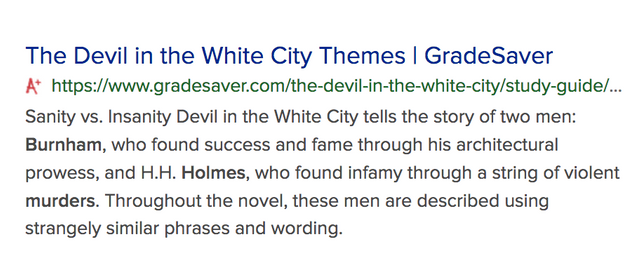
Even Mentions Utopia. Interesting, have you seen the series?
The White City of the fair is a sort of utopia, a promise of what a city could be but what it most certainly is not yet. It is clean, beautiful, sanitary, and safe; there are social services and public utilities, not to mention intellectual and artistic stimulation and numerous entertainments.
There is also a White Rabbit in Utopia.
H. H. Holmes was really Herman Webster Mudgett
Born on May 16, 1861 in Gilmanton, New Hampshire, Mudgett changed his name to Dr. H.H. Holmes (an apparent homage to Sherlock Holmes, as Larson mentions in his book) in 1886 after he began working in a pharmacy. History.com mentions that the owner of said pharmacy mysteriously disappeared before Holmes eventually took over the business.
- He Built A “Murder Castle” To Torture His Victims
Between 1891 and 1892, Holmes had a “Murder Castle,” which he dubbed a hotel, constructed in Chicago. It was a three-story building that he used as his own living quarters and a place to torture and kill his victims. According to Time, the “castle” apparently had windowless rooms, gas chambers, chutes made for disposing of the dead bodies, and even an incinerator to burn the bodies of his victims.
According to Murder by Gaslight, Holmes would dump dead bodies down a chute where they would go straight to a basement complete with a furnace and a dissecting table. The site also claims that he'd usually remove the flesh from the skeletons of the bodies, clean the bones, and sell the remains to medical schools.
Holmes was eventually caught by the authorities, but it wasn’t actually because of his murders. As explained by Crime Museum, it was, instead, due to an insurance scam — which was one of many — gone awry.
As Crime Museum points out, the insurance scam in question involved Holmes' “business” partner, Benjamin Pitezel. Holmes created a plan for Pitezel to fake his own death so that he could then run off with his life insurance money. Somewhere down the line, he decided to just murder Pitezel for real, but by then the authorities had already been onto him. He eventually stood trial and was hanged for Pitezel’s murder in 1896 at Moyamensing Prison in Philadelphia.
According to Mysterious Chicago, Holmes was paid by a number of newspapers to confess to his crimes. But the reason that there’s still not very much known about his life or his murders is that he gave different accounts of his doings to each source. He confessed to murdering a total of 27 people, though the number could be well over 200.
According to CrimeFeed, Holmes requested to be buried in a “double-deep coffin” covered with cement to prevent anyone from stealing and dissecting his remains, but he also may have made the request in an attempt to make it more difficult for his body to be identified. Rolling Stone reported in early May that body is now being exhumed because of a theory stating that the con artist convinced another prisoner to be executed in his place so that he could flee the country. But Larson, for one, isn’t convinced, as People reports; he recently told the AP that he has “absolute confidence the body in that grave is Holmes.”
Interesting a movie based on Burnham and Holmes came out a few years ago according to Bustle,
Leonardo DiCaprio is teaming up with Martin Scorsese once more to star in the director’s upcoming film based on Erik Larson’s 2003 nonfiction novel of the same name, The Devil in the White City. The film will be set in 1893, and it’ll tell the story of an architect named Daniel H. Burnham and an infamous serial killer named Dr. H.H. Holmes, whom DiCaprio is set to play.
They were designed by the country’s finest architects — such as Stanford White, Charles McKim, and Daniel Burnham — and its gardens and grounds crafted by Fredrick Law Olmsted, the landscape architect who designed New York’s Central Park.
Interesting what is under New York's Central Park.
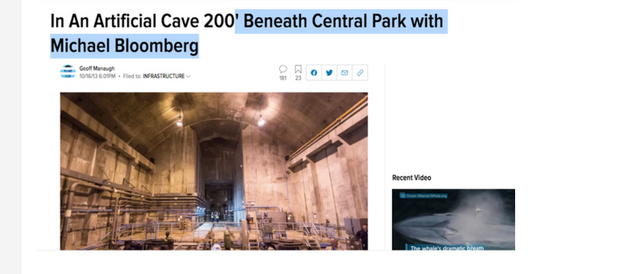
 .
.
See more on Holmes here,
The ships, a joint project of the governments of Spain and the United States, were constructed in Spain and then sailed to America for the exposition.
The electrotachyscope of Ottomar Anschütz was demonstrated, which used a Geissler tube to project the illusion of moving images.
Many of the buildings included sculptural details and, to meet the Exposition's opening deadline, chief architect Burnham sought the help of Chicago Art Institute instructor Lorado Taft to help complete them. Taft's efforts included employing a group of talented women sculptors from the Institute known as "the White Rabbits" to finish some of the buildings, getting their name from Burnham's comment "Hire anyone, even white rabbits if they'll do the work."
Almost all of the fair's structures were designed to be temporary; of the more than 200 buildings erected for the fair, the only two which still stand in place are the Palace of Fine Arts and the World's Congress Auxiliary Building. From the time the fair closed until 1920, the Palace of Fine Arts housed the Field Columbian Museum (now the Field Museum of Natural History, since relocated); in 1933 (having been completely rebuilt in permanent materials), the Palace building re-opened as the Museum of Science and Industry.[52] The second building, the World's Congress Building, was one of the few buildings not built in Jackson Park, instead it was built downtown in Grant Park. The cost of construction of the World's Congress Building was shared with the Art Institute of Chicago, which, as planned, moved into the building (the museum's current home) after the close of the fair.
The three other significant buildings that survived the fair represented Norway, the Netherlands, and the State of Maine. The Norway Building was a recreation of a traditional wooden stave church. After the Fair it was relocated to Lake Geneva, and in 1935 was moved to a museum called Little Norway in Blue Mounds, Wisconsin. In 2015 it was dismantled and shipped back to Norway, where it was restored and reassembled.[53] The second is the Maine State Building, designed by Charles Sumner Frost, which was purchased by the Ricker family of Poland Spring, Maine. They moved the building to their resort to serve as a library and art gallery. The Poland Spring Preservation Society now owns the building, which was listed on the National Register of Historic Places in 1974. The third is The Dutch House, which was moved to Brookline, Massachusetts.
Interesting Another Fire!
Since many of the other buildings at the fair were intended to be temporary, they were removed after the fair. The White City so impressed visitors (at least before air pollution began to darken the façades) that plans were considered to refinish the exteriors in marble or some other material. These plans were abandoned in July 1894, when much of the fair grounds was destroyed in a fire.
The fair ended with the city in shock, as popular mayor Carter Harrison, Sr. was assassinated by Patrick Eugene Prendergas.
The exposition is mentioned in the university's alma mater: "The City White hath fled the earth,/But where the azure waters lie,/A nobler city hath its birth,/The City Gray that ne'er shall die."
See a stellar link from Fine Warrior Michael Steele here,
https://www.youtube.com/watch?fbclid=IwAR15x4xJXdNWv8wFgLojtUpViHXvAeqiESr8nfLx6gM0cmr06u9ylt0HKL0&v=y_14DZIUCdE&feature=youtu.be
Sources, Reports, Connections
https://en.wikipedia.org/wiki/List_of_world%27s_fairs
https://www.britannica.com/place/Montauk-Building
https://www.britannica.com/biography/Daniel-Burnham/The-Worlds-Columbian-Exposition-of-1893
#ChicagoWorldsFair, #ColumbiaExposition, #JohnRoot, #DanielBurnham, #HHHolmes, #TheDevilInTheWhiteCity
Thank you to Great Warrior Michael Meredith for sharing this link from the following FB Post,
A must watch! Only a little over 5 min and well worth it as it hits on Many of them and the overall summary! #ChicagosWorldsFair, #ColumbianExposition, #WorldsFairs
The Unsettling Mystery of the World's Columbian Exposition | 1893 Chicago World's Fair & Others
From this FB Post,
Downvoting a post can decrease pending rewards and make it less visible. Common reasons:
Submit
Thank you Polly Suzanne Cox on Unifyd for this great link!
STOLEN HISTORY : LIFTING THE VEIL OF DECEPTION. PART 1.
https://www.bitchute.com/video/0M9y16SZa0Ne/
Downvoting a post can decrease pending rewards and make it less visible. Common reasons:
Submit
https://steemit.com/tunnels/@artistiquejewels/hot-springs-it-s-beauty-healing-power-and-rich-history-al-capone-tunnels-under-the-city-and-infamous-the-vapors-bombing-and
Downvoting a post can decrease pending rewards and make it less visible. Common reasons:
Submit